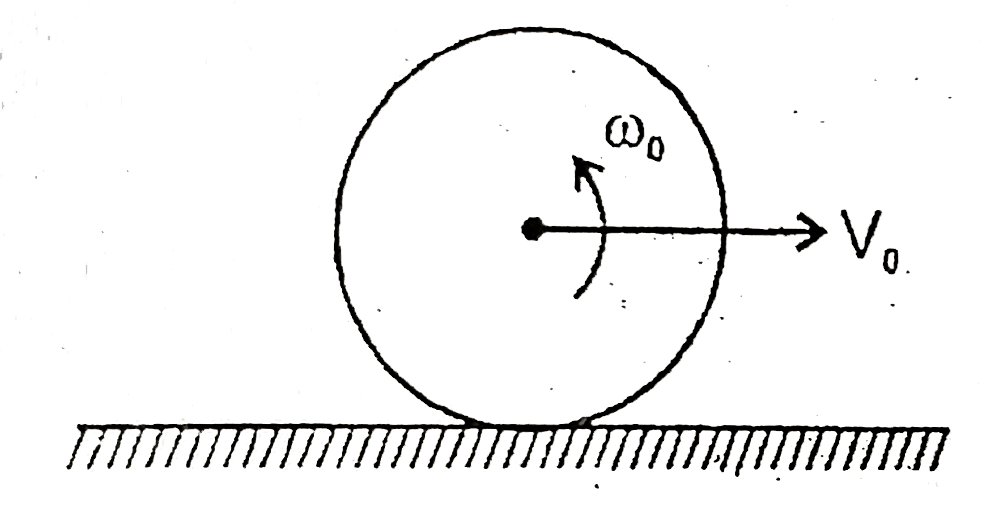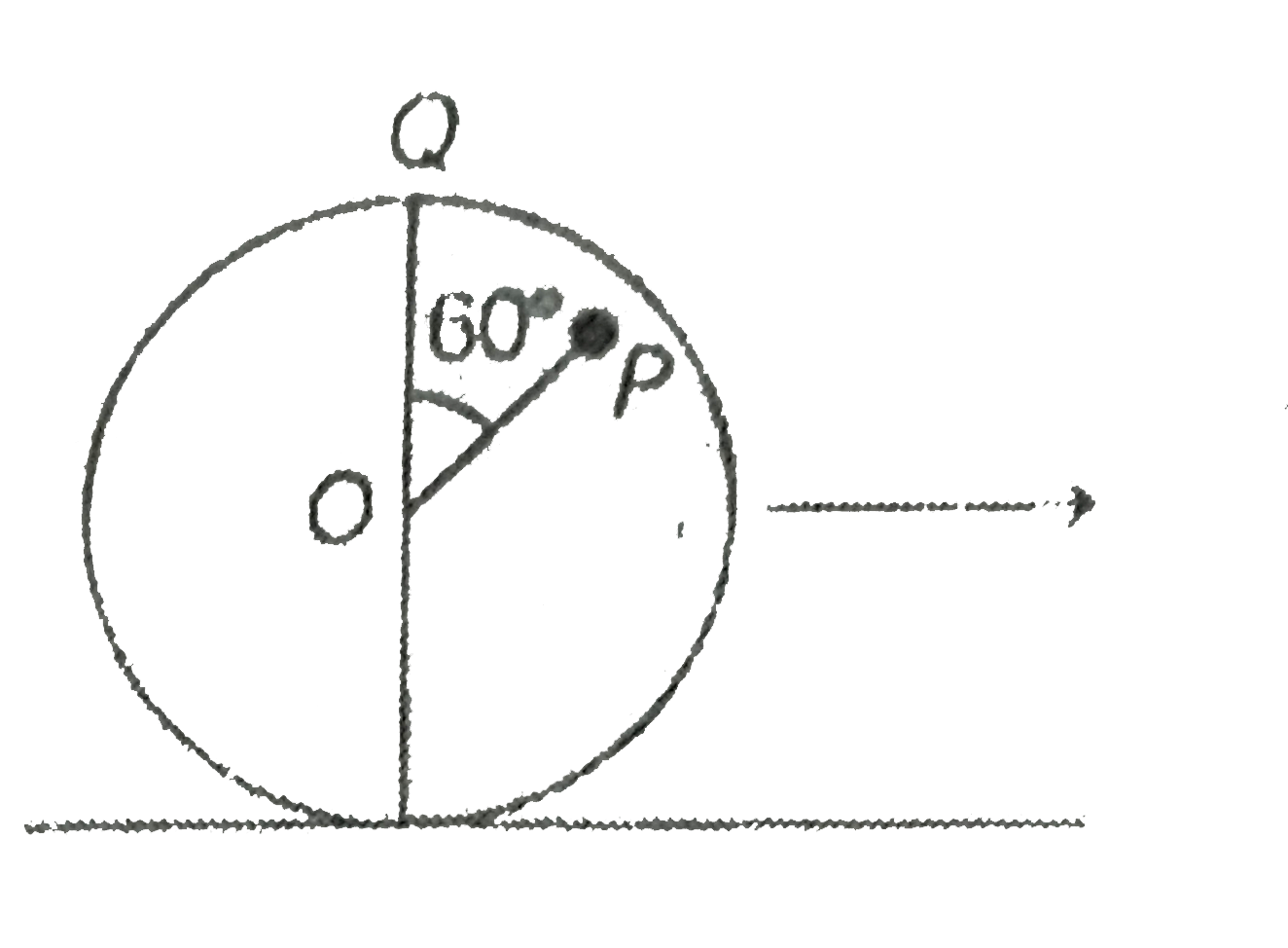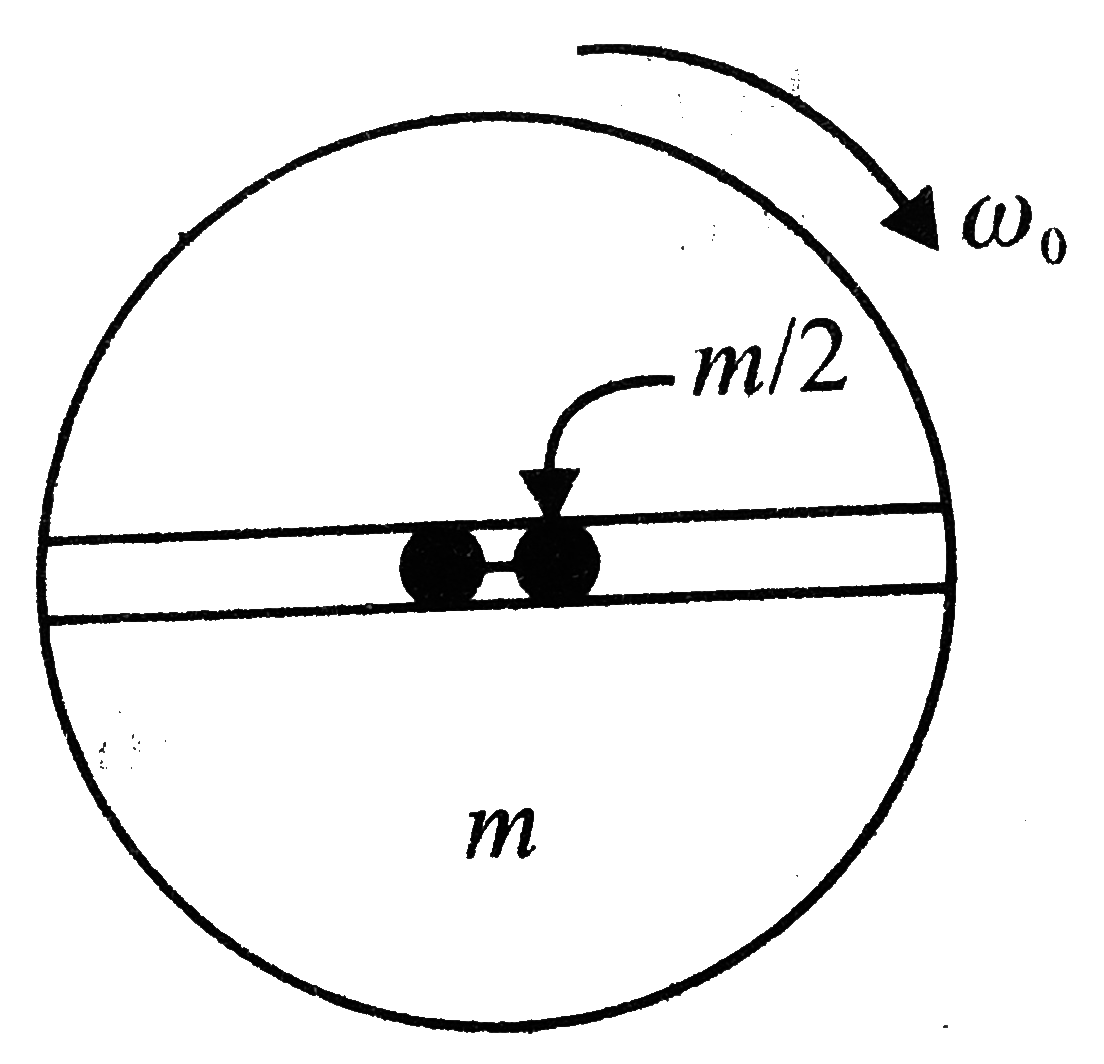A disc of radius R and mass m is projected on to a horizontal floor with a backward spin such that its centre of mass speed is v0 and angular velocity is ω0. What must be the minimum value of ω0 so that the disc eventually returns back?
To solve the problem, we need to determine the minimum value of the angular velocity ω0 such that the disc, projected with a backward spin, eventually returns back after sliding on the horizontal floor.
1. Understanding the Motion:
- The disc is projected with a center of mass speed v0 and an angular velocity ω0 in the backward direction. This means the translational motion is in one direction while the spin is in the opposite direction.
2. Friction Force:
- The friction force F acting on the disc will oppose the motion. The maximum static friction can be expressed as:
F=μN=μmg
- Here, μ is the coefficient of friction, m is the mass of the disc, and g is the acceleration due to gravity.
3. Deceleration Due to Friction:
- The friction will cause a deceleration (retardation) in the translational motion of the disc. The equation of motion can be written as:
v=u+at
- Setting v=0 (when the disc stops), we have:
0=v0−μgt1
- Solving for t1 (the time taken to stop):
t1=v0μg
4. Angular Motion:
- The angular motion of the disc is affected by the torque due to friction. The torque τ can be expressed as:
τ=F⋅R=μmg⋅R
- The moment of inertia I of a disc is given by:
I=12mR2
- The angular acceleration α can be found using:
τ=Iα⟹μmgR=12mR2α
- Simplifying gives:
α=2μgR
5. Time to Stop Rotating:
- The time t2 taken for the angular velocity to become zero is given by:
ω=ω0+αt⟹0=ω0−αt2
- Therefore:
t2=ω0α=ω0R2μg
6. Condition for Returning Back:
- For the disc to return back, the time t2 must be less than t1:
t2<t1
- Substituting the expressions for t1 and t2:
ω0R2μg<v0μg
- Simplifying this inequality gives:
ω0R<2v0⟹ω0>2v0R
Final Answer:
The minimum value of ω0 required for the disc to eventually return back is:
ω0≥2v0R
- The disc is projected with a center of mass speed v0 and an angular velocity ω0 in the backward direction. This means the translational motion is in one direction while the spin is in the opposite direction.
- The friction force F acting on the disc will oppose the motion. The maximum static friction can be expressed as:
F=μN=μmg
- Here, μ is the coefficient of friction, m is the mass of the disc, and g is the acceleration due to gravity.
- The friction will cause a deceleration (retardation) in the translational motion of the disc. The equation of motion can be written as:
v=u+at
- Setting v=0 (when the disc stops), we have:
0=v0−μgt1
- Solving for t1 (the time taken to stop):
t1=v0μg
- The angular motion of the disc is affected by the torque due to friction. The torque τ can be expressed as:
τ=F⋅R=μmg⋅R
- The moment of inertia I of a disc is given by:
I=12mR2
- The angular acceleration α can be found using:
τ=Iα⟹μmgR=12mR2α
- Simplifying gives:
α=2μgR
- The time t2 taken for the angular velocity to become zero is given by:
ω=ω0+αt⟹0=ω0−αt2
- Therefore:
t2=ω0α=ω0R2μg
- For the disc to return back, the time t2 must be less than t1:
t2<t1
- Substituting the expressions for t1 and t2:
ω0R2μg<v0μg
- Simplifying this inequality gives:
ω0R<2v0⟹ω0>2v0R
The minimum value of ω0 required for the disc to eventually return back is:
ω0≥2v0R
Topper's Solved these Questions
- ROTATIONAL MECHANICSBOOK - DC PANDEY ENGLISHCHAPTER - ROTATIONAL MECHANICSEXERCISE - Subjective Questions
2 Videos
- ROTATIONAL MECHANICSBOOK - DC PANDEY ENGLISHCHAPTER - ROTATIONAL MECHANICSEXERCISE - Level 2
1 Videos
- ROTATIONBOOK - DC PANDEY ENGLISHCHAPTER - ROTATIONEXERCISE - (C) Chapter Exercises
39 Videos
- ROTATIONAL MOTIONBOOK - DC PANDEY ENGLISHCHAPTER - ROTATIONAL MOTIONEXERCISE - Integer Type Questions
17 Videos
Similar Questions
A disc of radius 2 m and mass 100kg rolls on a horizontal floor, its centre of mass has speed of 20cm/s. How much work is needed to stop it ?
View SolutionA sphere of mass m is placed on a rough surface of coefficient of friction μ. Initially the sphere is given a velocity v0 and angular velocity ω0 as shown in figure. Find out the value of ω0 so that the sphere will come to rest after a certain time. Sphere has radius r.

View SolutionA uniform disc of mass m and radius R is released gentiy on a horizontal rough surface. Such that centre of the disc has velocity V0 towards right and angular velocity ω0 (anticlockwise) as shown.

Disc will certainly come back to its intial position if
View SolutionA uniform circular disc of radius r is placed on a rough horizontal surface and given a linear velocity v0 and angular velocity ω0 as shown. The disc comes to rest after moving some distance to the right. It follows that

View SolutionA billiard ball of mass m and radius r, when hit in a horizontal direction by a cue at a height h above its centre, acquired a linear velocity v0. The angular velocity ω0 acquired by the ball is
View SolutionA thin uniform circular disc of mass M and radius R is rotating in a horizontal plane about an axis passing through its centre and perpendicular to its plane with an angular velocity ω. another disc of the same dimensions but of mass M/4 is placed gently on the first disc coaxially. The angular velocity of the system now is 2ω/√5.
View SolutionA thin uniform circular disc of mass M and radius R is rotating in a horizontal plane about an axis passing through its centre and perpendicular to its plane with an angular velocity ω . Another disc of same dimensions but of mass 14 M is placed gently on the first disc co-axially. The angular velocity of the system is
View SolutionA disc of radius r rolls without slipping on a rough horizontal floor. If veloocity of its centre of mass is v0, then velocity of point P, as shown in the figure
(OP=r/2 and ∠QOP=60∘)is

View SolutionThe mass of a hoop of radius 0.30 m is 2kg. It rolls along a horizontal floor so that its centre of mass has a speed of 2 m/s. What is the work done to stop it ?
View SolutionA disc of mass m and radius R is free to rotate in a horizontal plane about a vertical smooth fixed axis passing through its centre. There is a smooth groove along the diameter of the disc and two small balls of mass m/2 each are placed in it on either side of the centre of the disc as shown in Fig. The disc is given an initial angular velocity ω0 and released.

The angular speed of the disc when the balls reach the end of the disc is
View Solution
